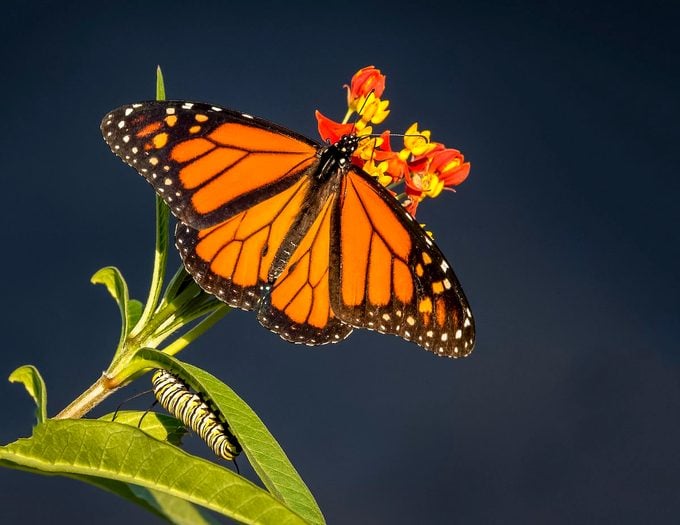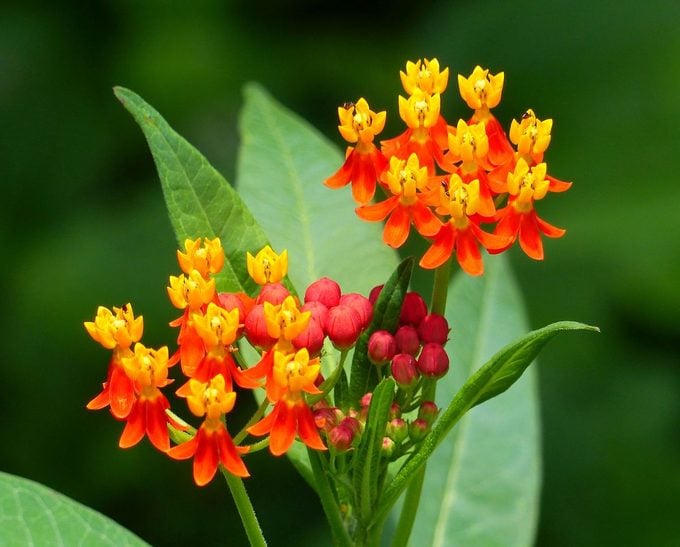Is Tropical Milkweed Bad for Monarchs?
Updated: Dec. 22, 2023
Should you avoid planting tropical milkweed for monarchs? Find out what garden experts say and find native milkweed varieties to grow instead.
Think Twice Before Planting Tropical Milkweed

The population of monarch butterflies has declined by as much as 90 percent in the last 20 years. Loss of habitat, milkweed and other native nectar plants is a major reason. Milkweed is the one plant monarch butterflies rely on to successfully complete their life cycles. Adult females lay eggs only on milkweed leaves. Gardeners are eager to help their favorite orange butterflies, and planting milkweed is one of the best ways to do that. But many experts recommend avoiding tropical milkweed (Asclepias curassavica). Here’s why.
While tropical milkweed is nonnative to the United States, it’s easy to grow and still beneficial to monarchs. But it doesn’t die back in the southern U.S. and California. This may encourage monarchs to stop short of their full migration. Tropical milkweed types also host a parasite that infects and harms monarchs. To reduce these problems, cut back the plants to a few inches high for the cool fall and winter months. Northern gardeners can grow the plants in a container and treat them as an annual.
Is that a yellow monarch butterfly in your yard?
“This male monarch butterfly (above) visited the tropical milkweed in my front garden in Florida. Most of my milkweed grows in our backyard butterfly garden. But when this patch of milkweed appeared I decided to let it grow, and it has been a magnet for monarchs. Although tropical milkweed is controversial, as long as I keep it trimmed after it blooms, the butterflies are healthy,” says Birds & Blooms reader Mary Lundeberg.
Check out 11 fascinating monarch butterfly facts.
Tropical Milkweed vs Native Milkweed

Fortunately, there are many alternatives that gardeners can grow to help monarchs. Replace tropical milkweed plants with one of the more than 65 native milkweed varieties that are available. Consult with a native plant specialist to find a milkweed native to your specific area. Or try these three types of milkweed that can be planted almost anywhere: common, swamp and butterfly weed.
The Monarch Joint Venture recommends the following regional milkweed species for California gardeners. Download a fact sheet at monarchjointventure.org.
- Mexican whorled (A. fascicularis)
- Showy (A. speciosa)
- Desert (A. erosa)
- California (A. californica)
- Heartleaf (A. cordifolia)
- Woolly (A. vestita)
- Woolly pod (A. eriocarpa)
Whichever native type of milkweed you choose, if it’s possible, start your seeds indoors under artificial lights. The seedlings will be ready to transplant in the garden once they are 3 to 6 inches tall and when the threat of frost has passed. Plan for about four to eight weeks of indoor growing time.
Is honeyvine milkweed invasive? Should you remove milkweed bugs? Here’s what you need to know.
After the dainty milkweed flowers stop blooming in late summer, their 2- to 4-inch seed pods burst open to reveal silky seeds that fly away with the wind, starting the growing cycle anew.
Next, learn what you need to know about raising monarch butterflies.




















